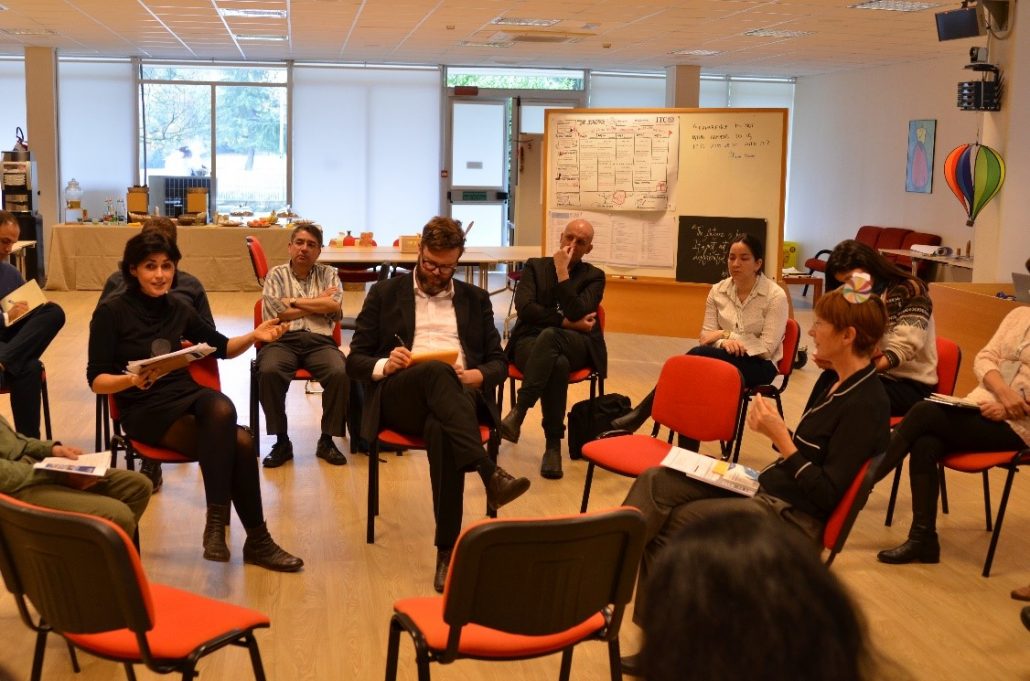Fishbowl

The art of active listening
Overview
The Fishbowl facilitates dialogue between experts, exposing others to their knowledge and expanding the collective understanding of a subject. Knowledgeable people (the fish) sit in circle to discuss a series of directional questions. They are surrounded by a larger group of observers in an outer circle (the bowl). In some variations, people can move from the bowl to the fish, to share the opportunity to speak and listen among all participants.
How to use it
- Foster dynamic participation and conversation
- Share expertise while avoiding lengthy presentations
- Build skills in listening, storytelling, pattern-finding, questioning, and observing
- Use as an alternative to traditional debates or panel discussions
How to apply it
Materials:
- Inner and outer circles of chairs, including more than needed, to encourage mobility between groups.
- Paper or flipcharts to record key points about the sessions.
Time/Steps:
- Identify 2 to 3 subject-matter experts or experienced participants and brief them on the Fishbowl process.
- Set up a small circle of chairs for the experts (fish) surrounded by a larger circle for the listeners (the bowl), including slightly more than the number of participants, to facilitate mobility.
- 5 to 10 minutes: Explain the process and learning objectives. Present the background informationas an interview with the ‘fish’ to provide targeted subject matter for the discussion.
- Continue as either an open or closed form of Fishbowl:
- An Open Fishbowl contains several empty chairs in the centre circle from the start. Any member of the audience can join the discussion by occupying an empty chair at any time. A current “fish” must voluntarily leave the centre circle to free a chair. The discussion continues with participants frequently entering and leaving the Fishbowl. Participants have more than one opportunity to move to the inner circle.
- All the centre chairs are occupied in a Closed Fishbowl. The facilitator splits the participants in two or more groups. One group are speakers, and the other groups become observers. The speakers enter the inner circle and speak for some time about the subject. When time runs out (or when no new points are added to the discussion), they leave the fishbowl and a new group enters the fishbowl and becomes the speakers. The new group continues discussing the previous issue. This may continue until all audience members have spent some time in the fishbowl. This approach is only appropriate when all participants have at least some level of prior knowledge of the subject.
- The outer circle must always silently observe. The facilitator should enforce this principle diligently. They prepare questions and comments and move into the circle when ready.
- Summarize the discussion after the allocated time is over. Debrief and review key points, interesting comments and the group’s feelings regarding particular issues. Allow the learners to develop their own conclusions and express them freely.
- Provide an overview document of the lessons learned and key resources for the participants after the exercise.
Time:
- Any form of Fishbowl requires a minimum timeslot of 1.5 hours.
How to adapt it
- Divide the participants into two groups to prepare 2-4 questions for the other group, to ensure that everyone participates. The inner circle has a discussion based upon the questions posed. When everyone in the inner circle has had a chance to speak, reverse circles to examine the second set of questions according to the fishbowl rules.
- A Feedback Fishbowl systematizes interaction between the inner and outer circle. After the “fish” have discussed the issue for approximately 15 minutes, they spin their chairs 180 degrees to face the outer circle. The outer circle shares comments and feedback directly to the “fish” in front of them. The inner circle again faces the centre and incorporates the new information into the conversation. After the conclusion of the second round of discussion, the participants in the inner circle switch places with those in the outer circle and the process is repeated.
- Invite people with similar opinions or experiences to sit in a Homogeneous Fishbowl, providing evidence and logic to support a cohesive perspective. This helps avoid wasteful disagreements at the early stages of the discussion and elaborates a clear concept for debate throughout the exercise.
- In contrast, a Heterogeneous Fishbowl requires one person representing each divergent viewpoint to sit in the fishbowl. The debate must be carefully managed by the facilitator to ensure that it is productive and examines the full variety of opinions equally.
- Multiple Fishbowls can address issues with large groups or when language barriers exist between participants. Assign a moderator to each fishbowl to record the reflections, and provide them with clear instructions and support during the exercise. Select representatives from each fishbowl to form a new central fishbowl after the first discussions. Decide according to the composition of the group if the debriefing would be more effective within the large group or back in the original multiple fishbowls.
Case study
Title:
Flexibility in the fishbowl method
Activity:
ILO Global Learning Event on best practices in conducting country policy analysis
Contact:
Tom Wambeke, t.wambeke@itcilo.org (DELTA)
Description:
At an ILO Global Learning Event on best practices in conducting country policy analysis, representatives of selected international development partner agencies and consultancy companies participated in a fishbowl discussion to respond to some provocative questions from which the ILO wished to learn.
The questions were presented by the moderator and elaborated by an ILO resource person, and discussed one by one: How do you strike a good balance between a generic standardized approach and that of a country specific approach? How is the country policy analysis used to inform policy making and policy development? How do you ensure quality, coherence and sustainability?
Five partner agency representatives were originally seated in the inner circle of the fishbowl, with the other six in an outer circle. Those in the outer circle rotated in to the inner circle to share perspectives. The ILO participants observed and reflected in silence. A nominated ILO rapporteur took notes of the discussion and presented a synthesis/key take-away points at the conclusion of day.
Tips
- More reserved groups may require encouragement to begin entering the inner circle of discussion. This can be helped by well-formulated learning objectives and introductions to the subject matter.
- Limitations can be placed on entering the inner circle in the interest of time or fairness, such as everyone being required to make a minimum or maximum number of contributions in the centre circle.
- If the outer circle seems to have more contributions to make after the fishbowl, open a Blog, Chat, Wiki or Discussion Forums UPDATE on the course webpage to capture their comments, reflections and questions.
- Decide at the start of the session how people should request a place in the inner circle. It will depend on the culture and composition of the group. Often, simply standing up to indicate interest is enough. A tap on the shoulder may also be helpful, but be wary of cultural taboos.
Resources
- Book from Learning Resources and Information: “The winning trainer”, Julius E. Eitington p.67-70.
- Collaboratively written instructions from the KS Toolkit: http://www.kstoolkit.org/Fish+Bowl?f=print
- Using the fishbowl for awareness-generating activities: http://www.edchange.org/multicultural/activities/fishbowl.html





